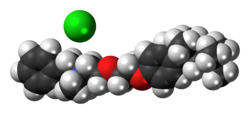Benzethonium chloride
 |
|
 |
|
| Names | |
|---|---|
|
Preferred IUPAC name
N-Benzyl-N,N-dimethyl-2-{2-[4-(2,4,4-trimethylpentan-2-yl)phenoxy]ethoxy}ethanaminium chloride
|
|
|
Systematic IUPAC name
Benzyldimethyl(2-{2-[4-(2,4,4-trimethylpentan-2-yl)phenoxy]ethoxy}ethyl)azanium chloride
|
|
| Identifiers | |
|
3D model (Jmol)
|
|
| 3898548 | |
| ChEBI | |
| ChemSpider | |
| ECHA InfoCard | 100.004.073 |
| EC Number | 204-479-9 |
| KEGG | |
| MeSH | Benzethonium |
|
PubChem CID
|
|
| RTECS number | BO7175000 |
| UNII | |
| UN number | 2923 |
|
|
|
|
| Properties | |
| C27H42ClNO2 | |
| Molar mass | 448.09 g·mol−1 |
| Melting point | 163 °C (325 °F; 436 K) |
| 40 g dm−3 (at 20 °C) | |
| Pharmacology | |
| D08AJ08 (WHO) R02AA09 (WHO) | |
| topical | |
| Legal status |
|
| Hazards | |
| GHS pictograms |
  
|
| GHS signal word | Danger |
| H301, H314, H400 | |
| P273, P280, P305+351+338, P310 | |
|
EU classification (DSD)
|
|
| R-phrases | R22 R37/38 R41 |
| S-phrases | S26 S36/39 |
|
Except where otherwise noted, data are given for materials in their standard state (at 25 °C [77 °F], 100 kPa).
|
|
|
|
|
| Infobox references | |
Benzethonium chloride, also known as hyamine is a synthetic quaternary ammonium salt. This compound is an odorless white solid, soluble in water. It has surfactant, antiseptic, and anti-infective properties, and it is used as a topical antimicrobial agent in first aid antiseptics. It is also found in cosmetics and toiletries such as mouthwashes, anti-itch ointments, and antibacterial moist towelettes. Benzethonium chloride is also used in the food industry as a hard surface disinfectant.
Benzethonium chloride exhibits a broad spectrum of microbiocidal activity against bacteria, fungi, mold and viruses. Independent testing shows that benzethonium chloride is highly effective against such pathogens as methicillin-resistant Staphylococcus aureus, Salmonella, Escherichia coli, Clostridium difficile, hepatitis B virus, hepatitis C virus, herpes simplex virus (HSV), human immunodeficiency virus (HIV), respiratory syncytial virus (RSV), and norovirus.
The US Food and Drug Administration (FDA) specifies that the safe and effective concentrations for benzethonium chloride are 0.1-0.2% in first aid products. Aqueous solutions of benzethonium chloride are not absorbed through the skin. It is not approved in the US and Europe for use as a food additive. Being a quaternary ammonium salt, it is more toxic than negatively charged surfactants. However, in a two-year study on rats, there was no evidence of carcinogenic activity.
...
Wikipedia
